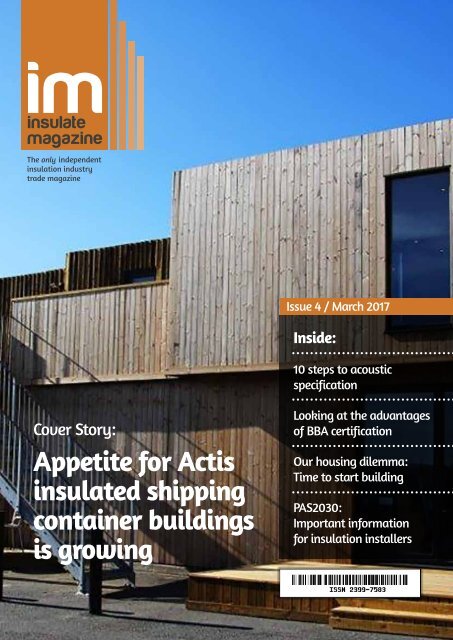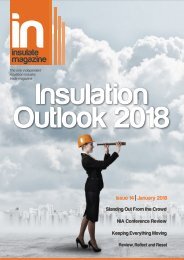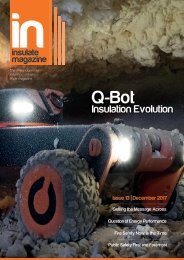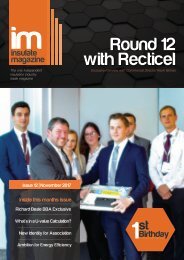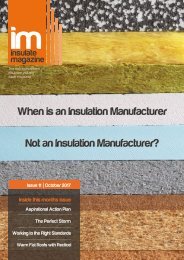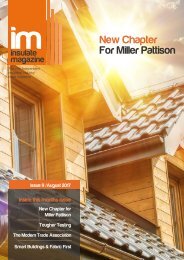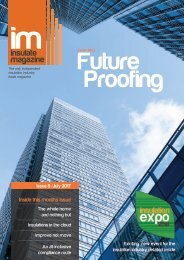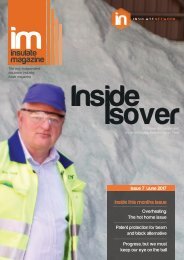Insulate Magazine Issue 4
Create successful ePaper yourself
Turn your PDF publications into a flip-book with our unique Google optimized e-Paper software.
The only independent<br />
insulation industry<br />
trade magazine<br />
<strong>Issue</strong> 4 / March 2017<br />
Inside:<br />
10 steps to acoustic<br />
specification<br />
Cover Story:<br />
Appetite for Actis<br />
insulated shipping<br />
container buildings<br />
is growing<br />
Looking at the advantages<br />
of BBA certification<br />
Our housing dilemma:<br />
Time to start building<br />
PAS2030:<br />
Important information<br />
for insulation installers
The only independent insulation industry trade magazine<br />
It takes bottle to specify<br />
insulation that’s better<br />
for the environment.<br />
TIMBER & RAFTER ROLL 40<br />
Saving energy and saving time on your build project?<br />
Superglass glass mineral wool insulation does both. It cuts<br />
energy bills, of course, and contains 84% recycled glass,<br />
stopping it going to landfill. And with Superglass, you get<br />
service that is second-to-none. Our Teamworks values mean<br />
we’ll work closely with you to deliver your ideal insulation<br />
solution, including same-day order confirmation and next-day<br />
delivery. Which means less time on site and lower costs.<br />
Our Timber & Rafter Roll is a lightweight, flexible option ideal for roofs, walls<br />
and floors with an A+ BRE Green Guide Rating. So for a greener future and great<br />
service, smart specifiers insist on Superglass.<br />
It’s a decision that really doesn’t take too much bottle.<br />
An exclusive publication for the insulation industry<br />
Published on a monthly basis by<br />
M4 Publications & Events Ltd<br />
Corser House, 17 Geen End, Whitchurch,<br />
Shropshire SY13 1AD<br />
Call 01948 759 351<br />
Outside of the UK +44 1948 759351<br />
Monday - Friday 9am - 5.30pm<br />
Website: www.insulatemagazine.co.uk<br />
Email: contact@insulatemagazine.co.uk<br />
SUBSCRIPTION INFORMATION<br />
Subscription is free for anyone within the UK and Channel<br />
islands. Anyone can subscribe for free online at www.<br />
insulatemagazine.co.uk/subscribe or by phone<br />
on 01948 759 351 subscriptions are available around<br />
the world free in digital format. Print subscriptions<br />
are available around the world, please call us<br />
for a quote. More information is available on<br />
www.insulatemagazine.co.uk<br />
Our subscriber list is occasionally made available to very<br />
carefully selected companies whose products or services<br />
may be of interest to you. Your privacy is of paramount<br />
importance to us and should you prefer not to be part<br />
of these lists then please email your details and a short<br />
message to contact@insulatemagazine.co.uk<br />
CLASSIFIED ADVERTISING<br />
Rate: No photo classified £25 for 20 words, each<br />
additional word costs £1. All classified advertising must<br />
be paid in advance. We must receive your classified advert<br />
at least two weeks prior to the publication date.<br />
WE DO NOT ACCEPT PHONE IN CLASSIFIED ADVERTISING<br />
In the first instance, email your advert to adverts@<br />
insulatemagazine.co.uk and await your invoice, once<br />
payment is received our design team will clarify<br />
the advert insertion with you directly. CLASSIFIED<br />
ADVERTISING APPEARS IN PRINT AND ONLINE. WE ARE<br />
NOT RESPONSIBLE FOR ERRORS AFTER PROOFING<br />
AND INSERTION.<br />
DISPLAY ADVERTISING.<br />
Contact one of our sales staff to discuss your requirements<br />
on 01948 759 351. Publisher reserves the right to reject<br />
any advertising that in its opinion is misleading, unfair<br />
or incompatible with the character of the magazine. We<br />
adhere to the IPSO code of practice<br />
for editors. Further information can be found at<br />
www.ipso.org.uk<br />
BACK ISSUES OR REPRINTS<br />
Digital back issues can be found online at<br />
www.insulatemagazine.com. For printed editions please<br />
email contact@insulatemagazine.co.uk , there will be a<br />
postage charge and handling fee of £5+VAT for each copy<br />
requested.<br />
CIRCULATION<br />
The magazine is sent to 30,000 per month with a print<br />
run of 20,000<br />
©M4 PUBLISHING & EVENTS LTD<br />
No part can be reproduced without the express permission<br />
of the publisher<br />
Facebook: www.facebook.com/insulatemag<br />
Twitter: www.twitter.com/insulatemag<br />
Youtube: www.youtube.com/insulatemag<br />
LinkedIn: www.linkedin.com/company/insulate-magazine<br />
ISSUE 4<br />
Contents<br />
Inside:<br />
A note from the Editor 4<br />
BRUFMA: Housing White Paper 6<br />
10 steps to acoustic specification 8<br />
The Rockwool Group unveils 12<br />
new brand identity<br />
Looking at the advantages of 14<br />
BBA Certification<br />
All change ahead for SAP assessments? 16<br />
Actis-insulated shipping container buildings 18<br />
Our housing dilemma: Time to start building 21<br />
PAS2030: Important information 23<br />
for insulation installers<br />
CERTIFICATE 89/2231<br />
Call 0844 381 4022 or visit www.superglass.co.uk<br />
insulatemag<br />
3
Insulation<br />
Welcome to issue 4<br />
Welcome to <strong>Issue</strong> 4 of <strong>Insulate</strong> <strong>Magazine</strong>, and a brand new look<br />
courtesy of our new creative team – hope you like it!<br />
Talk in the industry this month is around the latest Green Building Council report, and its<br />
stark warning that the UK needs to insulate more than one home every minute to the highest<br />
standard to ensure we meet our carbon emission targets by 2050.<br />
The target reduction in emissions is 80%, and around a third of that is attributed to poorly<br />
insulated buildings – so it’s clear something needs to be done, and fast!<br />
While the report presents a huge challenge, it’s also an unmissable opportunity to add energy<br />
efficiency (including retrofitting of insulation in the roofs, walls and floors of UK homes) as an<br />
infrastructure priority.<br />
The government have announced they’ll be working on policies for implementation as soon as<br />
possible, and here at IM we’ll keep you up to date with any further news.<br />
The continued support our magazine has had from you in the industry has been outstanding,<br />
and I look forward to meeting with you all and discussing the latest developments at EcoBuild<br />
very soon.<br />
Colin Heath, Editor<br />
Our latest arrivals have landed...<br />
...offering you 4 new lower lambda<br />
products to choose from<br />
Kingspan Kooltherm ® K103 Floorboard, K110 and K110 PLUS Soffit Board,<br />
and K118 <strong>Insulate</strong>d Plasterboard feature an advanced, fibre-free insulation<br />
core, enabling them to achieve an outstanding thermal conductivity of<br />
0.018 W/m . K. As a result, the products can enable buildings to be built to<br />
the upper levels of fabric performance with minimal thickness.<br />
www.kingspaninsulation.co.uk/lowerlambda<br />
Further information on the Kingspan<br />
range is available on:<br />
+44 (0) 1544 387 384<br />
literature@kingspaninsulation.co.uk<br />
www.kingspaninsulation.co.uk<br />
Pembridge, Leominster, Herefordshire HR6 9LA, UK<br />
®<br />
Kingspan, Kooltherm and the Lion Device are Registered Trademarks of<br />
the Kingspan Group plc in the UK and other countries. All rights reserved.<br />
4 www.insulatemagazine.co.uk
<strong>Insulate</strong> <strong>Magazine</strong><br />
Housing white paper<br />
Build homes faster but not<br />
at the expense of poorer<br />
performing buildings<br />
Simon Storer Chief Executive, BRUFMA<br />
Every government for as long as we can remember has promised to build the houses<br />
the country needs, so with the release of the much-anticipated housing White Paper,<br />
“Fixing Our Broken Housing Market”, at least this government is in line with its<br />
predecessors. Only time will tell if they are any more successful. Sadly the track<br />
record is not very encouraging.<br />
The intention is clear and we are certainly in favour of speeding<br />
up the process to deliver the number of houses that has been<br />
identified for so long. But this must not be at the expense of<br />
poorer performing buildings. Effective Building Regulation and<br />
building control is essential to deliver highly energy-efficient<br />
buildings and to continue to increase the building standards for<br />
the sector.<br />
BRUFMA is therefore keen to see continued growth in the new<br />
build housing in a sustainable way which makes the most<br />
efficient use of available land.<br />
The White Paper launches a consultation with a range of<br />
recommendations to increase numbers of homes being built in<br />
the UK. But there are likely to be many conflicting views so I<br />
hope the government doesn’t use this as a way of kicking the<br />
problem into the long grass. No matter how many houses are<br />
built we must ensure that all new housing is highly energy<br />
efficient in line with our climate change objectives. Just because<br />
there is a rush to build shouldn’t be an excuse to lower the<br />
quality of the thermal performance. And we certainly don’t<br />
want to have to come back and retrofit in 20 years because the<br />
houses we build today do not meet tomorrow’s requirements.<br />
Based in Hamilton, South Lanarkshire, we have been<br />
established for nearly 10 years and have been carrying<br />
out Roofing, Plumbing, Joinery, External Render, <strong>Insulate</strong>d<br />
Render and Painting Services across Scotland.<br />
Every government promises<br />
to build more houses,<br />
let’s hope this time they live<br />
up to their promises.<br />
We provide Building Services for:<br />
Private Residential Clients<br />
Housing Associations<br />
Local Authorities<br />
Commercial Developments<br />
We all know that good insulation as part of the ‘fabric first’<br />
approach to the whole building stock is essential, as this<br />
ensures the building envelope delivers high performance, low<br />
maintenance and long term energy efficiency which will enable<br />
the introduction of low operating temperature and efficient<br />
heating systems.<br />
The White Paper does recognise the need to continually review<br />
the current energy performance standards with regard to<br />
climate change targets and to domestic fuel poverty, but this<br />
must be extended to include the performance in flood risk areas<br />
of housing and the materials used in their construction. So we<br />
look forward to more details on how this can be achieved.<br />
Our Clients....<br />
Our Accreditations....<br />
For more information about BRUFMA visit<br />
www.brufma.co.uk.<br />
6 www.insulatemagazine.co.uk<br />
www.pro-cast.co.uk
<strong>Insulate</strong> <strong>Magazine</strong><br />
PART 2<br />
10 steps to acoustic<br />
specification<br />
Mike Carrick AMIOA Head of Acoustics, Siderise Group<br />
For over 40 years SIDERISE has been providing innovative insulation solutions for<br />
Acoustic, Fire and Thermal applications throughout the UK<br />
Step 3 - Identify the sound path / paths<br />
More often than not, it is not possible to reduce the noise at<br />
source or insulate the receiver. When this is the case, the only<br />
option is to consider how the sound energy travels from the<br />
source to the receiver and by what mechanisms. Is it airborne,<br />
impact, structure-born sound transmission, a direct sound path<br />
or a flanking sound path (indirect)?<br />
Only once the source, the receiver and the possible sound<br />
paths are understood, can a possible solution be considered<br />
to mitigate against it and therefore reduce the noise levels<br />
transmitted. An example would be a building façade, where the<br />
source may be a busy road, airport or railway line. The receiver<br />
would be the rooms inside and the path elements would be the<br />
façade and its acoustic properties.<br />
In very simple terms, if the receiver was an office, internal<br />
desired noise levels may be 45dB(A), but an apartment may be<br />
35dB(A). If you then know what the noise level of the source<br />
is, say for example, a road with noise levels of 70dB(A), then<br />
you would need the façade to reduce the sound by 25dB for an<br />
office, or 35dB for an apartment. Based on an allowance of 5dB<br />
difference between laboratory versus site measured values, the<br />
façade performance would likely be 30dB Rw for an office, or<br />
40dB Rw for an apartment.<br />
Step 4 - Understand the acoustic criteria<br />
There are many references to the dB, such as ‘Rw’, ‘Dnf,w’,<br />
‘LnT,w’, ‘DnT,w’ ‘Dne,w’ ‘Leq’ ‘Lmax’, to name but a few. It is very<br />
important to understand the differences between these as they<br />
are not numerically comparable. Stating a dB requirement is not<br />
enough. This is like degrees in temperature with 0 degrees<br />
Celsius, 32 degrees Fahrenheit, 273 degrees Kelvin and 427.67<br />
degrees Rankine all being the same temperature. So if you say<br />
300 degrees or 45dB it is not enough information. 45dB what?<br />
Commonly used in high rise façade buildings in reference to<br />
airborne sound insulation is ‘Rw’, ‘Dnf,w’ and ‘DnT,w’. An Rw<br />
value is a laboratory test value for the direct sound transmission<br />
of a building component or construction, such as a floor, wall,<br />
door, glass etc. A Dnf,w value is also a laboratory test value for<br />
the flanking sound transmission of a system, such as a Raised<br />
Access Floor, Suspended Ceiling System, Façade System etc.<br />
A DnT,w is a final site measured value for ‘room-to-room’ or<br />
‘floor-to-floor’ sound transmission and includes both direct and<br />
flanking sound transmission, airborne and structure born.<br />
In my next article, I’ll look into the design restraints when it<br />
comes to acoustic material and how you should always look<br />
to treat the lowest performing element.<br />
For further information about SIDERISE or for specific<br />
technical advice visit: www.siderise.com,<br />
email technical@siderise.com, or call 01656 730833<br />
8 www.insulatemagazine.co.uk
SOUND REDUCTION<br />
Superior sound insulation helps reduce unwanted<br />
noise from both internal and external sources.<br />
This is ROCK, re-engineered<br />
for a fast, easy and perfect fit.<br />
From volcanic rock to high performance building insulation. See<br />
ROCK re-engineered to provide high performance insulation solutions<br />
for today’s building projects. ROCKWOOL insulation is easy to use,<br />
dense, durable and performs because of its origins in natural stone.<br />
Discover how the transformation happens, and why ROCKWOOL<br />
insulation performs consistently across so many applications.<br />
THERMAL PERFORMANCE<br />
Stone wool insulation doesn’t just keep buildings warm<br />
today, it maintains its insulating properties for years to come.<br />
SEARCH ROCKWOOL INSULATION ORIGINS<br />
© 2016 ROCKWOOL Ltd. All rights reserved.<br />
DIMENSIONAL STABILITY<br />
Density, volume and structural integrity provide<br />
a perfect fit for maintaining performance.
<strong>Insulate</strong> <strong>Magazine</strong><br />
The only independent insulation industry trade magazine<br />
This is ROCK, re-engineered<br />
for a fast, easy and perfect fit.<br />
The Rockwool Group<br />
unveils new brand identity<br />
From volcanic rock to high performance building insulation. See<br />
ROCK re-engineered to provide high performance insulation solutions<br />
for today’s building projects. ROCKWOOL insulation is easy to use,<br />
Brand evolution for the global leader dense, in sustainable durable stone and wool performs solutionsbecause of its origins in natural stone.<br />
Discover how the transformation happens, and why ROCKWOOL<br />
insulation performs consistently across so many applications.<br />
The ROCKWOOL Group, the world’s leading global<br />
supplier of stone wool, unveils the latest evolution<br />
of its brand identity together with a new “Purpose”<br />
statement and corporate video.<br />
UCTION<br />
The Group’s brand evolution includes a new ROCKWOOL symbol – a graphic<br />
representation of a volcano. The symbol stands for the commitment to enrich<br />
modern living through processes and products that exist harmoniously, and it<br />
will be used across all ROCKWOOL Group daughter brands.<br />
This evolution aligns the branding of the ROCKWOOL Group’s diverse product<br />
portfolio to better demonstrate to our customers and other stakeholders the<br />
breadth and depth of how they use the natural power of volcanic stone to<br />
enrich and transform modern living, while addressing the challenges of the<br />
future. It will also support ROCKWOOL’s future geographical expansion.<br />
The new corporate video will be officially launched through a Thunderclap<br />
campaign – a large-scale scheduled social post, in which supporters share<br />
n helps reduce the message unwanted simultaneously to build awareness of the global challenges of<br />
and external modern sources. living, and the solutions that already exist today that can go a long<br />
way towards solving them.<br />
The new “Purpose” statement – “Release the natural power of stone to enrich<br />
modern living” – conveys that all businesses within the ROCKWOOL Group<br />
have one overarching goal: to enrich modern living by improving the life of<br />
everyone who comes in contact with their products.<br />
The ROCKWOOL Group’s stone wool products comprise a diverse range of<br />
original solutions, including fire-resilient, high-performing ROCKWOOL<br />
building insulations; Rockfon opera-standard acoustic panels; Rockpanel<br />
forward-designed external cladding; ROCKWOOL Technical Insulation custom<br />
industrial applications; Grodan substrates for abundant fresh produce with<br />
less water usage; and Lapinus mineral fibres for modern transportation, antivibration<br />
applications and water management solutions.<br />
ROCKWOOL’s products help people across the globe to create a more<br />
sustainable footprint and combat challenges related to increasing levels<br />
of urbanisation. Throughout the coming year, the ROCKWOOL Group will<br />
continue to focus on creating awareness on the challenges of modern living,<br />
and the solutions that already exist today that can go a long way towards<br />
solving them.<br />
12 www.insulatemagazine.co.uk<br />
SEARCH ROCKWOOL INSULATION ORIGINS<br />
I am proud of the ROCKWOOL Group’s<br />
long heritage in harnessing the power<br />
of one of the world’s most abundant<br />
natural resources in sustainable and<br />
innovative solutions that help solve the<br />
challenges of modern living. The updated<br />
brand identity marks an important<br />
evolution in the way we talk about our<br />
company, conveying a consistent vision<br />
and shared heritage across our diverse<br />
product portfolio’s full range.<br />
Mirella Vitale, ROCKWOOL Senior Vice President for<br />
Group Marketing, Communications & Public Affairs<br />
insulatemag<br />
Th<br />
for<br />
From<br />
ROCK<br />
for to<br />
dense<br />
Disco<br />
insula 13
<strong>Insulate</strong> <strong>Magazine</strong><br />
<strong>Insulate</strong> <strong>Magazine</strong><br />
The only independent insulation industry trade magazine<br />
A site for<br />
sore eyes:<br />
Looking at the<br />
advantages<br />
of BBA<br />
Certification<br />
As you well know, major<br />
construction work on building sites<br />
involves a huge amount of product<br />
and materials checking, not least<br />
to make sure everything meets the<br />
exacting requirements of Building<br />
Regulations. This can be stressful at<br />
the best of times and a helping hand<br />
is always welcome.<br />
BBA Agrément certificates are<br />
regarded as quite simply the<br />
best assurances you can get<br />
for your off-site products.<br />
With BBA’s 50 years of<br />
unrivalled expertise in<br />
building and construction<br />
certification, it’s easy to<br />
see why.<br />
That’s why more and more people are coming to the BBA for<br />
off-site certification of their products. For many years now, our<br />
work in the offsite construction sector has brought peace of<br />
mind to hundreds of architects and manufacturers alike.<br />
BBA Agrément Certificates are widely read and respected<br />
by industry decision-makers who want to select innovative<br />
products that have been thoroughly assessed by the BBA.<br />
Our assessors have decades of experience in evaluating<br />
Offsite Construction, and we are currently assessing many<br />
new systems, adding to the many already approved including<br />
insulated concrete formwork, SIPs and framed systems.<br />
Of course, our main focus is on the requirements of Building<br />
Regulations — not just in England and Wales, but also in<br />
Scotland and Northern Ireland. But we go much further than<br />
that. We want to ensure that a system is not only waterproof,<br />
warm and structurally sound; it has to be durable, too. No-one<br />
wants to buy a system with a short life expectancy, so we seek<br />
to ensure that it will last for an appropriate period of time.<br />
Neither are our assessments simply desk exercises.<br />
As well as testing, we go out to the factory to check system<br />
documentation and control, making sure that the specification<br />
we approve is capable of being produced consistently.<br />
We also go out on site to see units being offloaded and<br />
installed. That’s because we know that what may seem simple<br />
when explained in a dry office or factory can turn out to be<br />
very different on a building site.<br />
Once we have gathered data from testing, factory inspections<br />
and site surveillance, we consider how we can use it to establish<br />
that the requirements of Building Regulations and other<br />
statutory or non-statutory documents have been met.<br />
clientservices@bba.star.co.uk | 01923 665300<br />
www.bbacerts.co.uk<br />
14 www.insulatemagazine.co.uk<br />
insulatemag<br />
15
<strong>Insulate</strong> <strong>Magazine</strong><br />
The only independent insulation industry trade magazine<br />
All change ahead<br />
for SAP assessments?<br />
Michael Brogden Technical Director at Darren Evans Assessments<br />
The Standard Assessment Procedure (SAP) offers an indication of a home’s energy<br />
performance and is calculated using Government approved methodology based<br />
on standard usage patterns. Following a recent consultation by the Department of<br />
Business Energy and Industrial Strategy (BEIS) on changes to SAP, Michael Brogden,<br />
Technical Director at Darren Evans Assessments, takes a look at some of the proposals.<br />
Within the document there were 19<br />
proposed amendments to SAP that<br />
would not only bring it more in-line<br />
with how we as home owners interact<br />
with our homes, but also look to close<br />
loopholes within the SAP Assessment<br />
process itself and enable the results<br />
of the SAP Calculation to better reflect<br />
performance.<br />
There were no proposed changes to<br />
the limiting fabric targets or notional<br />
dwelling targets within the new<br />
proposal, for Part L1A or L1B. It had been<br />
proposed that the targets currently<br />
outlined within the 2012 regulations<br />
would remain the same. The SAP 2012<br />
Appendix R outlines the current notional<br />
dwelling values that are outlined within<br />
SAP for new build dwellings.<br />
The limiting fabric values for Part L1B<br />
(domestic change of use or renovation<br />
projects) have not changed or been<br />
updated since 2010. These values were<br />
unchanged when SAP was amended<br />
in 2012.<br />
Old houses, old regulations<br />
When you consider there are nearly 30<br />
million dwellings across the UK and that<br />
approximately 85% of all housing that<br />
will exist in 2050 has already been built,<br />
this highlights the potential impact<br />
that existing buildings have in meeting<br />
the Government’s carbon-reduction<br />
targets. Sadly, nothing has been done<br />
to improve the performance of these<br />
leaky inefficient dwellings beyond the<br />
standards that have been set in 2010.<br />
If there is no change in the next revision<br />
of the regulations, then this performance<br />
gap will continue to increase.<br />
If housing represents 16% of the total<br />
UK CO 2 emissions then would it not be<br />
beneficial to investigate how we can<br />
better reduce the emissions from this<br />
section of the market?<br />
PSI Values<br />
The other amendment within the<br />
consultation document relating to the<br />
fabric focused on the application of<br />
PSI values within the SAP Calculation.<br />
PSI values are a measure of heat<br />
loss through non-repeating junctions<br />
around a building. At present, SAP 2012<br />
Appendix K has a list of approved values<br />
outlined within Table K1.<br />
These approved values are able to be<br />
used within a calculation if a building<br />
follows accredited thermal junction<br />
principles outlined.<br />
The consultation proposes the removal<br />
of Table K1 discontinuing the ability for<br />
calculations to benefit from the use of<br />
these approved values. If these approved<br />
values are no longer used within<br />
calculations, then default or calculated<br />
values will need to be used. This will<br />
represent a higher heat loss through the<br />
fabric of the building. The consultation<br />
is also proposing an increase in the<br />
default Y-Value within SAP. The Y-value<br />
in the SAP is a measure for the heat<br />
loss through the non-repeating thermal<br />
bridging areas of a building in W/m²K,<br />
at present, if the thermal junctions are<br />
not measured then a default Y-Value is<br />
applied to the calculation.<br />
This value currently sits at 0.15, but the<br />
proposal is to increase the value to 0.20.<br />
Currently, in some SAP Calculations<br />
where the measured thermal junctions<br />
give a calculated Y-Value greater than<br />
0.15, the measured value can be ignored<br />
and the better-performing default<br />
whole building Y-Value can be selected.<br />
The consultation is seeking to stop this<br />
process from happening and ensure that<br />
the heat loss of the building is measured<br />
and accurately represented within the<br />
calculation.<br />
The responsibility would then rest<br />
with insulation and building product<br />
manufacturers to calculate the<br />
performance of PSI values through<br />
thermal junctions to ensure that the<br />
heat loss through these parts of the<br />
building is accurately represented<br />
and to ensure that the Target Fabric<br />
Energy Efficiency (TFEE) is achieved.<br />
Without calculated PSI values certain<br />
calculations may struggle to achieve the<br />
TFEE target, placing a greater weight of<br />
further renewable measures to achieve<br />
the Target Emission Rating.<br />
Lighting changes<br />
There are no lighting controls specified<br />
in the SAP Calculation methodology at<br />
present and there are none proposed in<br />
the changes. The consultation outlines<br />
changes to being able to better describe<br />
the lighting that is used, as well as<br />
differentiate properties that use more<br />
energy efficient lighting. Currently<br />
lighting has to be over 45 lumens per<br />
circuit watt to be counted as lowE and<br />
the calculation seeks an input in % as<br />
to how much of the provided lighting<br />
complies with this standard.<br />
This is a section of the SAP Calculation<br />
that needs to be tightened up as there<br />
is little information provided at present<br />
to confirm the lighting used in the<br />
calculation. However, the consultation<br />
could go further and propose a lighting<br />
control data entry field to better<br />
represent not only the lighting used, but<br />
the way in which it is controlled to ensure<br />
lighting is not inappropriately used.<br />
Hot water and heating<br />
There are changes also proposed that<br />
will enable the EPC to better represent<br />
the running costs of the building it<br />
illustrates, as at present the certificate<br />
is a poor description of the running cost<br />
of the buildings they represent. Some of<br />
the ways in which the consultation seeks<br />
to bring about this change is through<br />
hot water methodology and the SAP<br />
heating regime.<br />
Any steps to improve the accuracy of<br />
representing technologies within the SAP<br />
Calculation or to alter the assumptions<br />
within the calculation methodology to<br />
more accurately represent the way in<br />
which we use our homes is a positive<br />
step in the right direction.<br />
The proposed changes to SAP in making<br />
it more accurate are certainly a good<br />
thing because it will more accurately<br />
represent how energy efficient buildings<br />
are. However, the BEIS consultation could<br />
have gone further, particularly with more<br />
of a focus on insulation and fabric. There<br />
should also be more industry regulation<br />
to support the modelling and calculation<br />
of thermal bridges.<br />
16 www.insulatemagazine.co.uk<br />
insulatemag<br />
17
<strong>Insulate</strong> <strong>Magazine</strong><br />
<strong>Insulate</strong> <strong>Magazine</strong><br />
The only independent insulation The only industry independent trade insulation magazineindustry trade magazine<br />
Case study<br />
Appetite for Actis-insulated<br />
shipping container buildings<br />
is growing<br />
South West Steel Buildings, based in Newquay, has been insulating its distinctive units<br />
with two of the three products in the Actis Hybrid range — honeycomb insulation<br />
Hybris and insulating breather membrane Boost ‘R Hybrid — for the past couple of<br />
years because of the impressive thermal efficiency they offer, and the ease and speed<br />
with which they can be installed.<br />
Recent projects have included two 5,000 sq<br />
ft office blocks and 16 self-contained 400<br />
sq ft live work units at Prow Park business<br />
village on the Treloggan Industrial Estate<br />
in Newquay, and a 2,000 sq ft golf club at<br />
Whitsand Bay.<br />
The company is hoping to carry out a<br />
pilot residential project later this year. The<br />
homes, whose wall and roof U-value will<br />
be around 0.17, would be let at a fair rent<br />
or purchased through shared equity or<br />
ownership and would form part of a mixeduse<br />
development of homes, offices, retail<br />
units, community hubs and workshops<br />
to create a varied social environment. If<br />
successful, SWSB hopes this will pave the<br />
way for further projects in Cornwall and<br />
elsewhere in the UK.<br />
“All the local authorities that we have<br />
approached love the concept, and can<br />
really see the potential benefits stemming<br />
from the use of converted containers<br />
as residences,” explained development<br />
manager Brian Curnow.<br />
“We have met with some fantastic support<br />
from both the council and local politicians<br />
alike, but due to the pioneering nature<br />
of what we are doing we have met with<br />
a few stumbling blocks and have been<br />
working through them for a good part of<br />
2016 in order to take our product to market,<br />
hopefully in 2017.”<br />
The venture began a few years ago with<br />
the creation of a mini retail workshop and<br />
office development in Newquay whose<br />
units were available on a monthly rental<br />
basis to help businesses concerned about<br />
a long term commitment during difficult<br />
economic times.<br />
A special technique developed by<br />
the company eliminates technical<br />
issues by moving the dew point – a<br />
problem experienced on the interior of<br />
the conversion in some other similar<br />
constructions – to the outside of<br />
the building.<br />
Brian says the CE marked, NHBC<br />
approved, LABC and LABSS compliant<br />
Actis Hybrid products are very quick and<br />
easy to install and help avoid thermal<br />
bridging as they are flexible and can fit<br />
round corners.<br />
Using breather membrane Boost ‘R<br />
Hybrid massively reduces the risk of<br />
interstitial condensation, guarantees air<br />
tightness and can protect the building<br />
from precipitation and wind driven rain.<br />
Reflective and watertight, yet vapour<br />
permeable, it’s used on the cold side of<br />
roofs and walls. Because water vapour<br />
molecules are smaller than those in<br />
water droplets it lets moisture out but<br />
doesn’t let water in.<br />
Thermal modelling trials carried out<br />
by certification body BM TRADA have<br />
shown that Actis insulated membranes<br />
have a dramatic impact on counteracting<br />
thermal bridging and act as excellent<br />
thermal blankets.<br />
The shipping containers are just one<br />
of a number of off site construction<br />
techniques increasingly choosing Actis<br />
Hybrid projects – with others including<br />
timber frame buildings, park homes<br />
and ecopods.<br />
A Cornish company which<br />
specialises in converting shipping<br />
containers into offices, live-work<br />
units, pop-up restaurants and<br />
even a golf club is aiming to<br />
expand into residential projects<br />
during 2017.<br />
Since then the concept has proved<br />
increasingly popular. The 40ft containers,<br />
which can be configured in a variety<br />
of ways and are strong enough to be<br />
stacked eight high, cost about two thirds<br />
of the price of brick and block or timber<br />
frame equivalents.<br />
A recent competition for builders and merchants highlighted just how speedy<br />
it is to install the honeycomb Hybris panels. Videos of competitors in action<br />
show it really is a doddle (www.youtube.com/playlist?list=PLy8ZiNLWw-<br />
X3HWwc4T3HNozoRdGs95h-X), and a range of ‘how to’ video guides at<br />
hybrid.insulation-actis.com/how-to-insulate-a-timber-frame-wall-with-hybrisinsulation<br />
give tips on how to install the product.<br />
A free online simulator, at hybrid.insulation-actis.com/simulator enables users to<br />
estimate the U-value of an Actis Hybrid project in seconds.<br />
South West Steel Buildings’ first 5,000 sq ft office block at Prow Park in Newquay - insulated with Actis Hybris and Boost ‘R Hybrid.<br />
www.insulatemagazine.co.uk<br />
18<br />
19
Our Housing Dilemma:<br />
Time To Start Building<br />
Darren Evans Managing Director, Darren Evans Assessments<br />
The scale of our housing problem is immense with a great chasm between demand and<br />
supply, escalating prices across the UK to levels way beyond what a first time buyer<br />
can ever hope to achieve. In a bid to reform the market and boost the supply of new<br />
homes, the Government’s much-awaited housing White Paper, “Fixing Our Broken<br />
Housing Market, was greeted with cautious optimism by some, but is a much needed<br />
step in the right direction.<br />
To put some of the key housebuilding pledges in perspective,<br />
the figure of £1.4 billion allocated to the housing sector will<br />
lead to the construction of 40,000 new affordable homes across<br />
the country, but in terms of the target rate of 250,000 houses<br />
a year, this equates to the same number of houses in Newcastle<br />
and Sunderland put together. Do we have the capability of<br />
building the equivalent of two cities per year?<br />
The government is also committed to ‘bringing a halt to the<br />
decline in housing affordability.’ I don’t believe you can bring<br />
a halt to the affordability issue. All we can do is reduce that<br />
decline as there is no way you can stop a problem overnight<br />
that has been going on for years.<br />
The series of tweaks to planning laws is a good thing. Councils<br />
will be able to cut planning permissions to last just two years<br />
instead of their current three, in what some have termed a ‘useit<br />
or lose it’ threat to developers. What would be even better is<br />
putting a deadline on when a building needs to be completed. A<br />
deadline on the completion of a project will shift the emphasis<br />
from the housing provider to the interests of the potential<br />
homeowner.<br />
There is no mention on the impact of new housing on schools,<br />
hospitals and transportation which leads to the longstanding<br />
‘not in my backyard’ or NIMBY syndrome. What can we do to<br />
educate people to support building new homes? Is it not better<br />
to build on brownfield land or in deprived areas rather than<br />
adding to cities where there are already existing issues with<br />
schools, hospitals and infrastructure?<br />
If you build homes outside of existing cities then these areas<br />
become more affordable. People might have to move 30-50<br />
miles from where they currently are, but they escape the<br />
current housing crisis in that area. It therefore relieves the more<br />
built-up areas and elevates another previously deprived area to<br />
a better place. The place they have left also improves because<br />
there is more space for people.<br />
When it comes to support for local planning authorities, why<br />
has it taken so long to figure out that 40% of local authorities<br />
are reporting inaccurately on their projected growth? Why has<br />
this not been picked up or supported? Surely, this will lead to<br />
the the right homes, in the right places.<br />
With 60% of all properties constructed by only 10 developers,<br />
it’s great they are increasing competition with incentives to<br />
help small builders who are more dynamic and better for the<br />
economy. They recruit locally and their profit margins are not<br />
as aggressive as the largest commercial builders. Their desire to<br />
turn things around is a lot quicker and slicker than the bigger<br />
outfits and they are also better at producing sustainable and<br />
high quality homes.<br />
While it is no silver bullet, the housing White Paper is a good<br />
start and a road to somewhere from which all parties can ‘build<br />
on’. It would however benefit all of us to understand the longer<br />
term vision, not just in terms of the current government, but<br />
with consecutive administrations.<br />
For further information visit<br />
www.darren-evans.co.uk<br />
insulatemag<br />
21
<strong>Insulate</strong> <strong>Magazine</strong><br />
PAS2030:<br />
Important Information<br />
for Insulation Installers<br />
Kingspan Insulation<br />
‘Facades and Fire Safety:<br />
Routes to Compliance’ CPD<br />
Kingspan Insulation is<br />
delighted to offer its free<br />
Royal Institute of British<br />
Architects (RIBA) certified<br />
Continuing Professional<br />
Development (CPD)<br />
exploring the regulatory<br />
requirements for fire<br />
safety when installing<br />
rainscreen and masonry<br />
façades in habitable high<br />
rise buildings above and<br />
below 18 metres.<br />
The ‘Façades and Fire Safety: Routes to Compliance’ CPD discusses the various<br />
ways to comply with the fire safety requirements of the Building Regulations<br />
and Standards, and the relative merits of each approach. By the end of the<br />
CPD, it should be clear what factors need to be considered and what is deemed<br />
acceptable by Fire Safety Engineers and Building Control Bodies, as well as<br />
warranty and insurance providers. In addition to providing example case<br />
studies, the presentation also covers legislation and guidance in England,<br />
Wales and Scotland that is pertinent to these projects.<br />
RIBA CPDs provide self-directed, informal learning that ensures architects and<br />
construction professionals have access to a wealth of training material that<br />
is up-to-date and aids career growth. The CPD’s RIBA Approved status means<br />
that it is worth double points for architects seeking to maintain chartered<br />
status and demonstrates Kingspan Insulation’s keen interest in maintaining<br />
high standards, whilst continuing to improve upon current skills and<br />
proficiencies.<br />
As members of the RIBA CPD Providers Network, Kingspan Insulation can also<br />
offer guidance on fire safety when specifying premium performance rigid<br />
phenolic insulation for buildings above 18 metres.<br />
The industry’s largest standalone<br />
event of the year will<br />
be held in Nottingham this<br />
November.<br />
To enter or to book a table for<br />
this prestigious event, visit<br />
www.insulationawards.co.uk<br />
The new PAS2030 was published on 1st February 2017 and<br />
contains significant new, additional requirements and obligations<br />
on insulation installers. Companies carrying out work under the<br />
new Energy Company Obligation (ECO) from 1st April 2017 and<br />
any other Government Schemes will be required to work to the<br />
new requirements and be fully compliant by 1st June 2017.<br />
If insulation installers fail to meet the full requirements of<br />
PAS2030 they will not be able to undertake work, and any work<br />
they do undertake which does not comply under the PAS2030<br />
will be rejected and therefore they will not get paid.<br />
We understand that there is a significant<br />
lack of awareness and understanding<br />
of the new PAS2030 among installers<br />
generally which is of great concern to<br />
us. Therefore the NIA is issuing briefings<br />
and guidance to its members on the<br />
new PAS2030 and what they will need<br />
to do in order to comply. We are also<br />
providing details to specifiers including;<br />
Local Authorities, Housing Associations<br />
and Energy Companies and urging them<br />
to specify the use of NIA members for<br />
added assurance and recourse.<br />
Neil Marshall<br />
Chief Executive of the<br />
National Insulation Association<br />
22 www.insulatemagazine.co.uk<br />
insulatemag<br />
23


